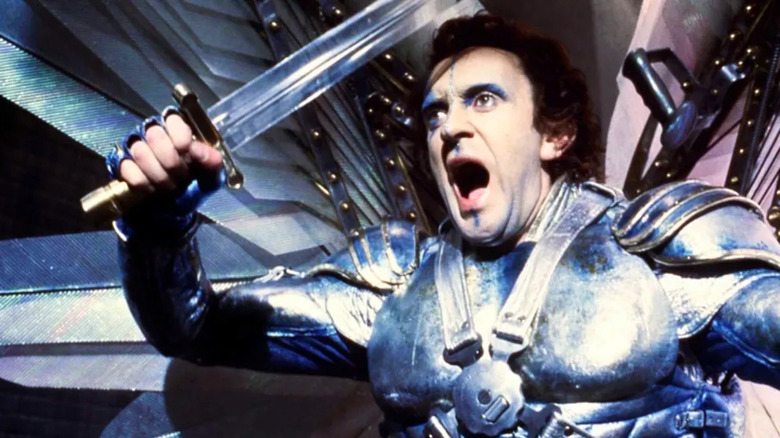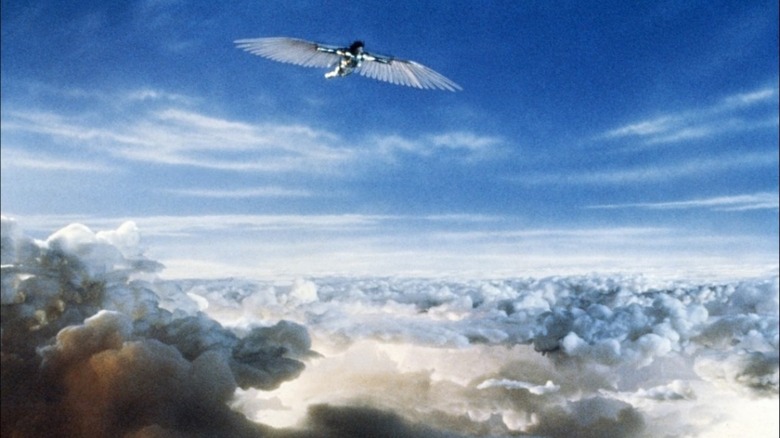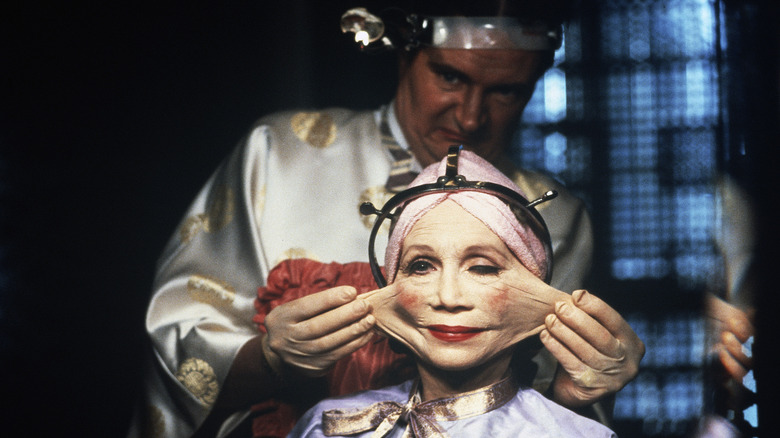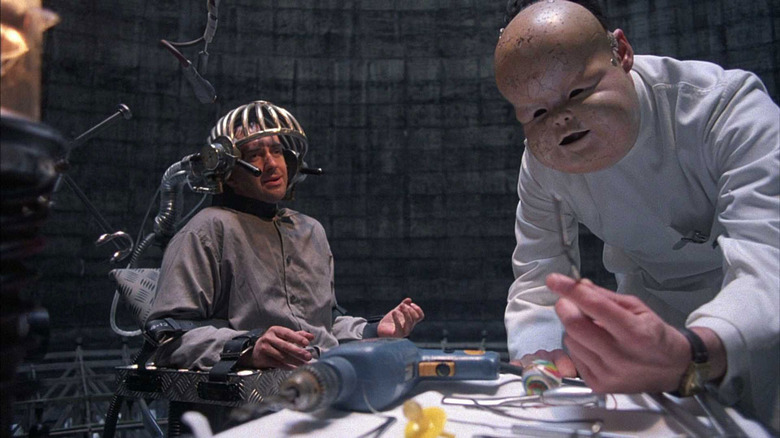Terry Gilliam Credits Brazil For Pulling Him Out From Monty Python's Shadow
Five Oxbridge "superior beings" and one American "barbarian at the gates," to use Terry Gilliam's own words; that was the lineup for "Monty Python's Flying Circus," the comedy troupe that took irreverent aim at the social and class boundaries of stuffy British society and, in their anarchic way, the very format of comedy itself.
For his part, Gilliam was the often-overlooked member of the gang, not only an outsider by nationality and class but also due to his role within the Pythons. As the animator, he worked alone and made far fewer appearances in their sketches, often taking on gurning grotesques that the others didn't really want to play. As a result, he never really had a defining screen persona. While we remember John Cleese and Michael Palin from the Dead Parrot sketch or the Ministry of Silly Walks, and Eric Idle as the insinuating spiv in the Nudge-Nudge routine, Gilliam's screen presence was fleeting.
Despite this, it was Gilliam's main day job that provided the silly putty that somehow bound it all together, his animations providing free-association surrealist bridges between skits. His style was crude but incredibly effective, mashing up high art, vintage magazine cuttings, weird-looking machinery, and his own bizarre paintings. His stream-of-consciousness doodlings also provided the opening sequence and the show's defining image: a giant Cupid's foot unceremoniously stomping on the title card with a loud, rude squishing sound.
All the Pythons made the transition to the big screen although only the two Terrys, Jones and Gilliam, found their way behind the camera, starting with co-directing "Monty Python and the Holy Grail." Unsurprisingly, it was Gilliam, who had the imagination to dream up those wild animations and also put the ideas on screen, who proved the most successful, although it took him a while to get out of the Python slipstream.
Terry Gilliam makes his masterpiece
After co-directing "Monty Python and the Holy Grail," Gilliam branched out in new directions while still remaining in the fantasy realm that was so well-suited to his visual style. First, there was "Jabberwocky," a wildly uneven medieval comedy based on the nonsense verse by Lewis Carroll, and the far more polished "Time Bandits," a family fantasy film that was an unexpected box office success.
The latter opened the door for Gilliam to make "Brazil," a project he had difficulty getting off the ground since before "Bandits" got the green light. Envisioned by the director as "Nineteen-Eighty-Four for 1984," it went into production in George Orwell's landmark year and draws favorable comparisons to the author's most famous work, a dystopian black comedy set in a retro-futuristic totalitarian state "somewhere in the 20th century." The story centers on Sam Lowry (Jonathan Pryce), an ambitionless pencil-pusher who dreams of escape from the bureaucratic drudge around him, only to get drawn to his doom after delivering a rebate check to the widow of a man who fell foul of the state's sinister "information retrieval."
Gilliam's vision is bold, and the first hour of "Brazil" is a marvel as he fully immerses us in his comically nightmarish world, a creaky police state overseen by monolithic government bodies, every facet of life wrapped up in red tape and endless paperwork by petty self-serving bureaucrats. The apathetic public is bombarded with propaganda encouraging them to inform on each other as a terrorist campaign enters its 13th year, and the all-encompassing clutches of the government are symbolized by the ugly ducts intruding on every home and public space. With no one apparently knowing who is in charge, the country runs on paranoia and buck-passing, the cogs kept turning by the barely-functioning antiquated tech.
Brazil takes Terry Gilliam to the next level
Aside from the astonishing visual style, another thing that sets "Brazil" apart from Terry Gilliam's previous films is its structure. "Jabberwocky" and "Time Bandits" still have the episodic nature of the "Python" movies, whereas "Brazil" is a far more coherent and satisfying narrative as a whole, building a fully realized world and developing ideas that recur and pay off; Sam's soaring heroic dreams; the comeuppance of a pair of vindictive heating engineers; Sam's mother's addiction to plastic surgery, and so on. All these ideas are threaded seamlessly throughout the story, finally helping Gilliam escape the "Pythonesque" label. Gilliam concurs:
"We made 'Jabberwocky,' which was, you know, Mike Palin was starring in it, Terry Jones is in it, and it was very Pythonic on many levels, and I was judged on Pythonic criteria, and it wasn't supposed to be a 'Python' film. It was trying to be something else. It was very interesting, and in countries that didn't know 'Python,' it was received very well, in countries that liked 'Python' it was sort of torn apart. 'Time Bandits' was an important one because even though it was, again, in some ways you could say a series of sketches...it is the most successful thing I've done there, which opened up the doors for me in Hollywood, and it actually led to the making of 'Brazil,' which then closed the doors."
There is still a Python connection in "Brazil," although it is one of the most inspired pieces of casting in the film. Michael Palin's innate niceness is inverted as he plays Jack Lint, Sam's old friend, a shameless boot-licker and smiling torturer for the state. Palin has a key role in the brilliantly downbeat conclusion, which had a big part to play in supposedly closing those Hollywood doors on Gilliam.
Terry Gilliam takes on the studios
After the success of "Time Bandits," Universal Pictures and 20th Century Fox clubbed together to put up the $15 million budget for "Brazil," with a clause in Terry Gilliam's contract giving him the final cut, provided he delivered a film no longer than 2 hours and 5 minutes (via Los Angeles Times). The cut he turned in was 2 hours 17 minutes, but the main issue, it seemed, was that Gilliam's unhappy ending made the executives extremely nervous about the film's commercial appeal.
Thus began a protracted dispute that became known as "The Battle of Brazil." Sidney Sheinberg, the Universal chairman, said he'd sell the picture for half their stake rather than release it the way Gilliam intended. Gilliam fought back, publicly accusing Sheinberg of trying to bully him out of his editing rights. As the battle rumbled on, Sheinberg insisted on re-cutting the film, resulting in the ghastly "Love Conquers All" ending.
Undeterred, Gilliam took to the trade papers challenging Universal to release his version and got Los Angeles film critics onboard with surreptitious screenings of the original cut. They voted "Brazil" and Gilliam among the year's best films and directors and the studio finally relented, releasing Gilliam's original vision (via Culture.org).
As it turned out, the executives' concerns about the film's marketability came to pass. "Brazil" was a flop, making just under $10 million back against its $15 million budget (via Box Office Mojo). Nevertheless, it has gone on to become a revered cult classic and was voted 54th in the BFI's list of the greatest British films of all time. As for Gilliam's relationship with Hollywood, it remained prickly but he wasn't the outcast he likes to make out, even despite his open contempt towards the head honchos and bean-counters at the studios.
The barbarian made good
After "Brazil," Terry Gilliam went on to make an even more elaborate box office bomb, "The Adventures of Baron Munchausen." While mounted on a sumptuous scale far larger than anything the director had attempted before, it was cumbersome and disjointed and something of a step backward. Perhaps due to the nature of the story, built around the tall tales of a legendary bullsh**ter, it felt more akin to "Jabberwocky" and "Time Bandits" with its rambling, episodic structure. The result was an even bigger flop than "Brazil," making just $8 million versus its whopping (for the time) $46 million budget (via Box Office Mojo).
Nevertheless, the doors to Hollywood weren't completely closed to the irascible visionary, and Gilliam atoned in the '90s by making two of his most conventional and commercially successful films, "The Fisher King" and "12 Monkeys." While both movies were more typically crowd-pleasing, the director was still able to trade in his distinctive visual style. Both films also brought in Oscar nominations, giving a tantalizing indication of what Gilliam might have achieved if he was prepared to edge a little further into the mainstream without totally compromising his vision.
Instead, he reverted to type, chasing (literally) quixotic passion projects and directing films with limited appeal, from his full-on adaptation of "Fear and Loathing in Las Vegas" to the virtually unwatchable "Tideland." Still, the much-loved director has definitely managed to carve out his own unmistakable niche in the last 40 years of cinema, going from Pythonesque to Gilliamesque, which also happens to be the title of his "Pre-posthumous Memoir." Not bad for the self-declared "Barbarian" who started out making weird cartoons for the Flying Circus.




